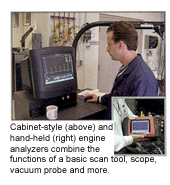When most people think of an engine analyzer, they think of a big box console with automated test capabilities that can detect a wide variety of faults. There are still some machines like these today, but many of the features of a traditional engine analyzer are now available in top-of-the-line scan tools.
An engine analyzer typically combines the functions of a basic scan tool, ignition scope, lab scope, infrared exhaust analyzer, vacuum probe and multimeter with a computer, large screen display and printer. Some have all of these features while others offer “add-on” modules so you can equip the analyzer with the features you want.
 Top-of-the-line engine analyzers have all of these features, plus “smart” software that allows it to interpret vehicle data and identify things that are out of range and might be causing a problem. This level of sophistication is typically found in OEM service bay analyzers as well as some top-of-the-line hand-held analyzers, tablet analyzers and cabinet-style analyzers.
Top-of-the-line engine analyzers have all of these features, plus “smart” software that allows it to interpret vehicle data and identify things that are out of range and might be causing a problem. This level of sophistication is typically found in OEM service bay analyzers as well as some top-of-the-line hand-held analyzers, tablet analyzers and cabinet-style analyzers.
No Comparison
Basic scan tools and scopes, by comparison, are essentially simple tools that require smart users. The same goes for infrared exhaust analyzers and even multimeters and most other pieces of test equipment. Diagnostic tools such as these can read and display all kinds of detailed information, but a basic scan tool or scope does not interpret or analyze what it sees. It only shows PIDS (performance information data), voltage values or waveforms that the user must know how to read and use to diagnose a fault. So without some kind of smart software to guide the user, no scan tool or scope can tell a good sensor reading or waveform from a bad one. Analysis falls on the shoulders of the person who is using the tool – which requires a considerable amount of knowledge and expertise to interpret, understand and use the information. (In order to get the most return out of your equipment investment, make sure your employees receive the proper training to use the equipment.)
Diagnosis may also require accessing vehicle specifications in manuals, an electronic database or online. Most OEM engine analyzers are tied into the vehicle manufacturer’s service database. For independent shops that purchase an aftermarket engine analyzer, you may be able to get an integrated software package that includes repair information, estimating capabilities and shop management features. It all depends on the analyzer and what’s available from the equipment manufacturer. Service information can also be obtained separately by subscribing to ALLDATA, Mitchell 1, Identifix or an OEM online website.
Takes Know-How
A basic scan tool is something every technician must have and know how to use. Scan tools are great for pulling codes and reading system data, and if the tool has bidirectional capability, it can also be used to run various actuator tests, relearn procedures or to reflash the PCM. The more powerful scan tools may also have a built-in scope function to display multiple voltages and sensor values as waveforms for comparison purposes. Such tools are much more powerful than a basic scan tool, but are not on the same level as a full-blown engine analyzer.
One of the biggest limitations of simple scan tool diagnostics is what to do when no DTCs (Diagnostic Trouble Codes) are found when a vehicle has an obvious driveability or emissions problem, or worse yet, an intermittent fault. The user has to know what to look for and how to use the information to make a diagnosis. Not everybody who uses a scan tool has the expertise to make full use of the tool’s capabilities. Nor does everyone who uses a scan tool always remember to run a series of basic tests to check such things as battery voltage, charging voltage, cranking compression and intake vacuum to rule out electrical and mechanical problems that might affect engine performance.
An engine analyzer with smart software has the built-in brains to do all of this and more. By combining the capabilities and functions of numerous diagnostic tools into one, using these functions to gather information, and then analyzing the information it has gathered, a smart engine analyzer can take much of the guess work out of diagnosing faults.
How does it do this? The “expert” programming recognizes values that are abnormal or are out of range, flags the “bad” readings and then tells you what might be causing the bad readings (check this, check that, etc.). You may have to perform some additional diagnostic checks or inspect certain parts or circuits, but at least you’ll have a road map and a direction to go. That’s a far cry from jumping to conclusions based on incomplete data and replacing parts that don’t need to be replaced.
The bottom line is that an engine analyzer with smart software can significantly improve your diagnostic accuracy and reduce the time it takes to identify and isolate faults. It can reduce comebacks because it increases your odds of finding and fixing the problem correctly the first time, not the second or third time.
The trend in recent years has been to develop new hand-held test equipment and better scan tools that combine multiple functions into one tool. These tools are a good value for the money and give you more diagnostic bang for your buck. But some still lack the automated test menus and smart diagnostics of a traditional cabinet-style analyzer that are necessary to identify problems and possible causes.












